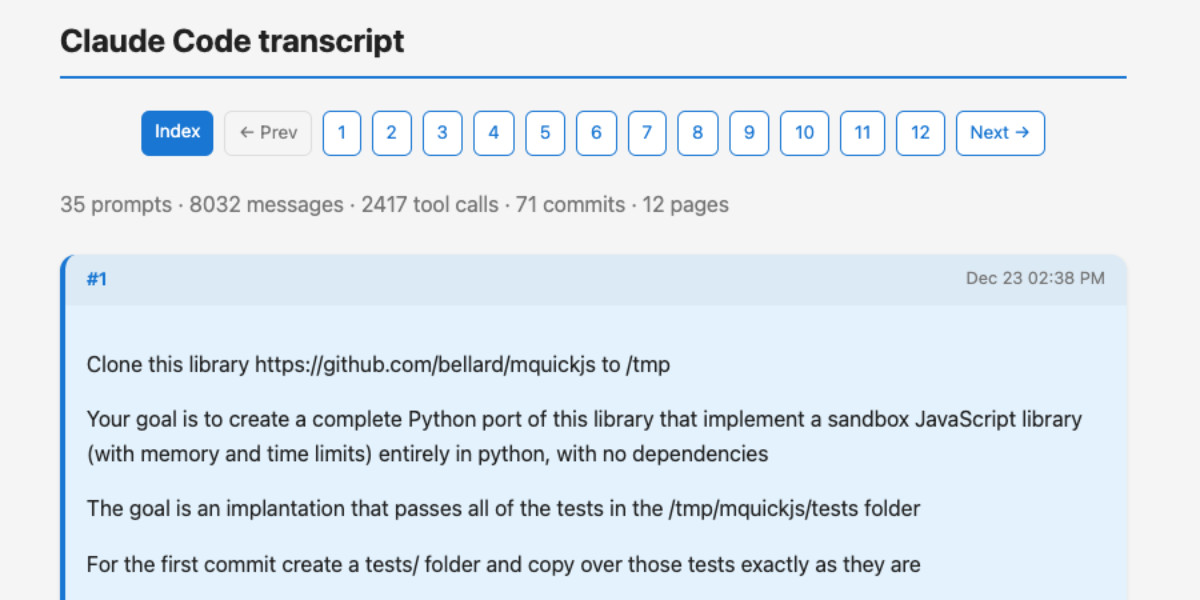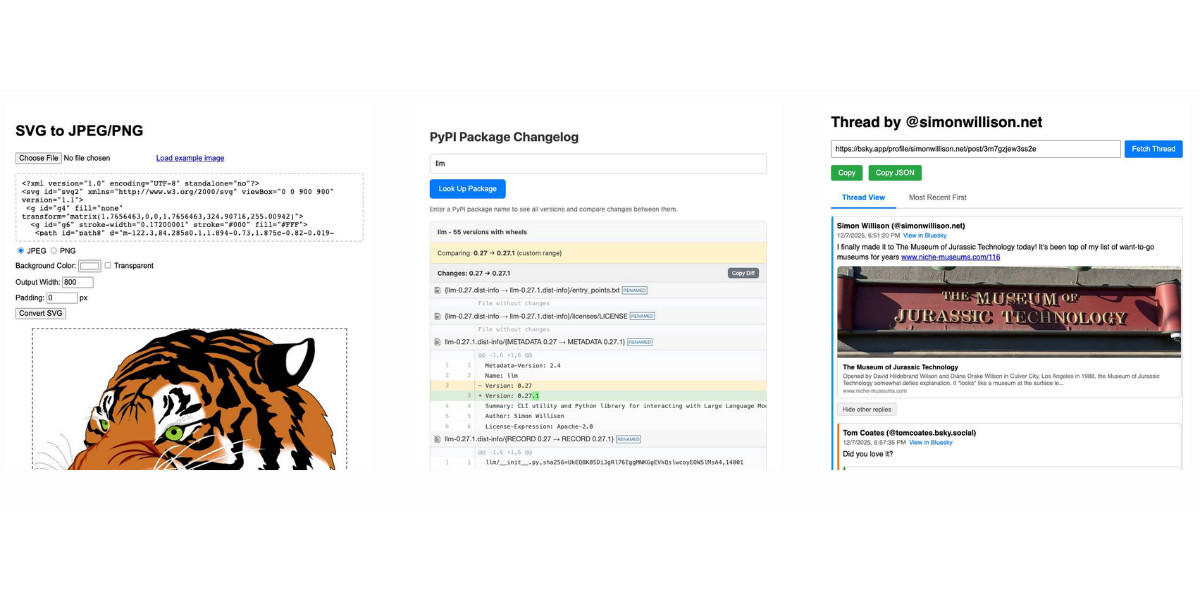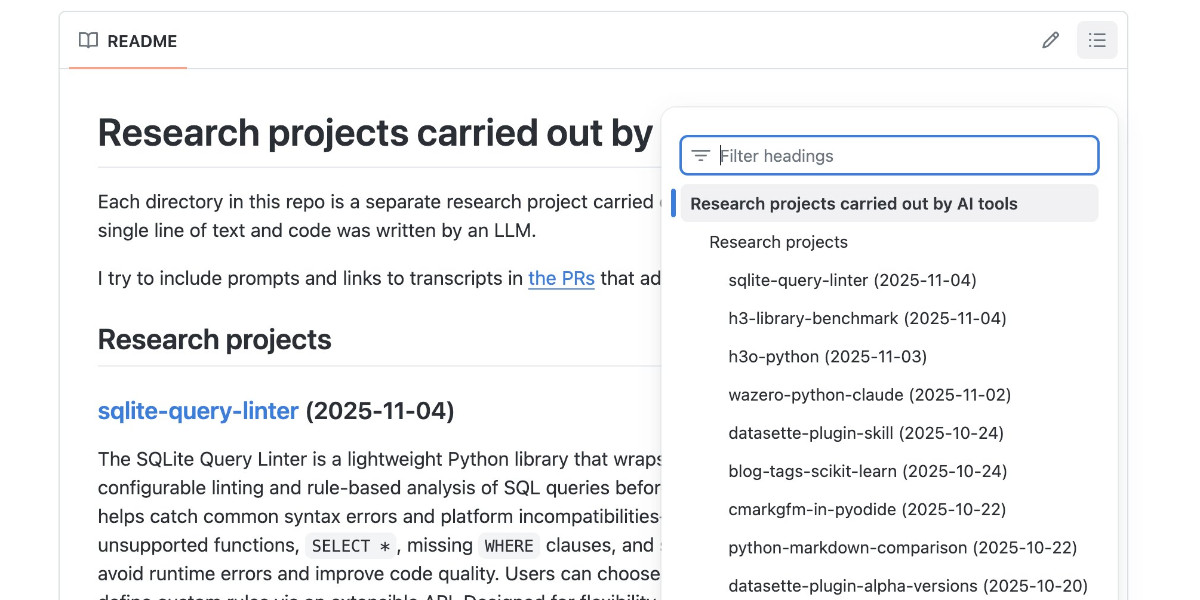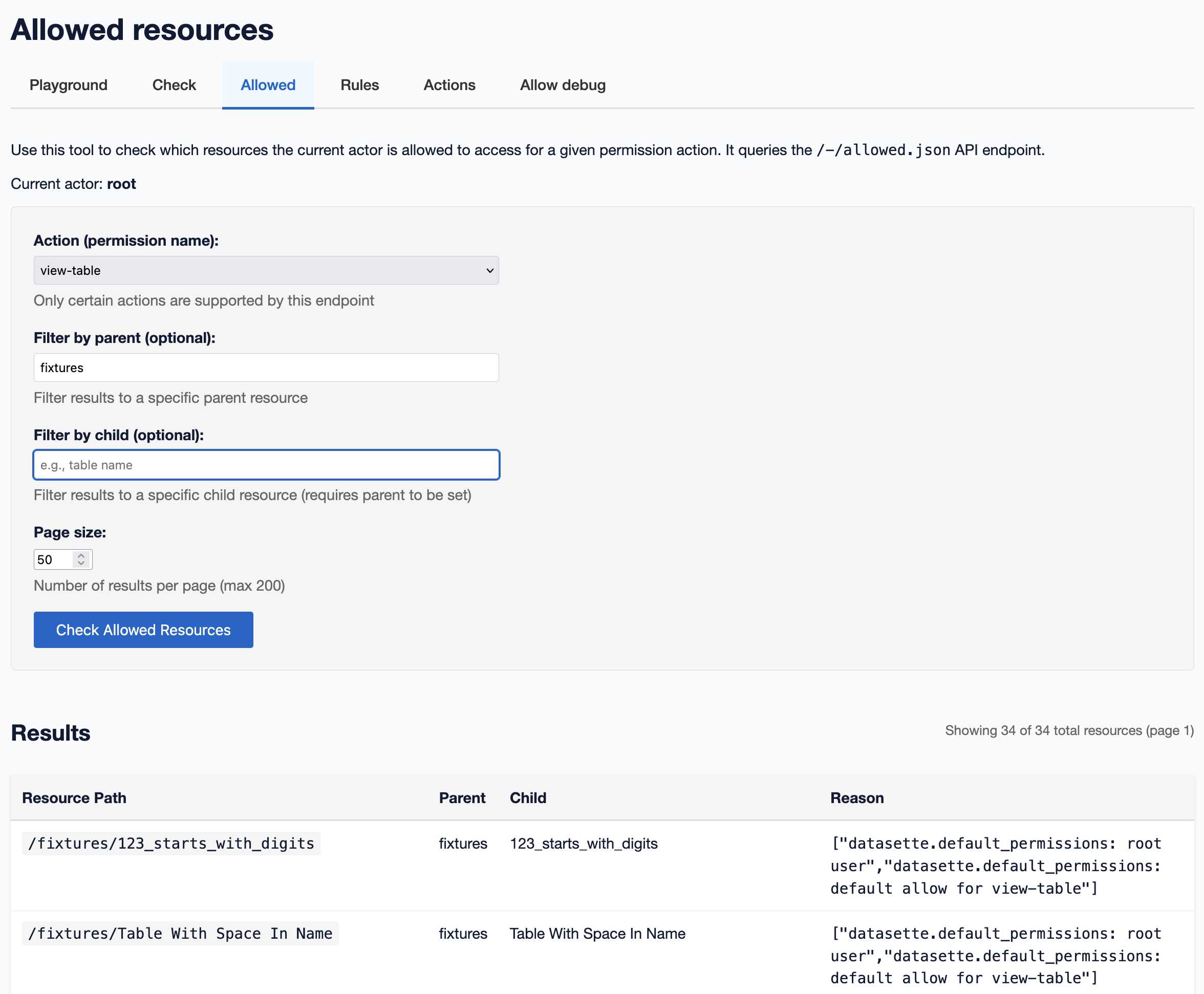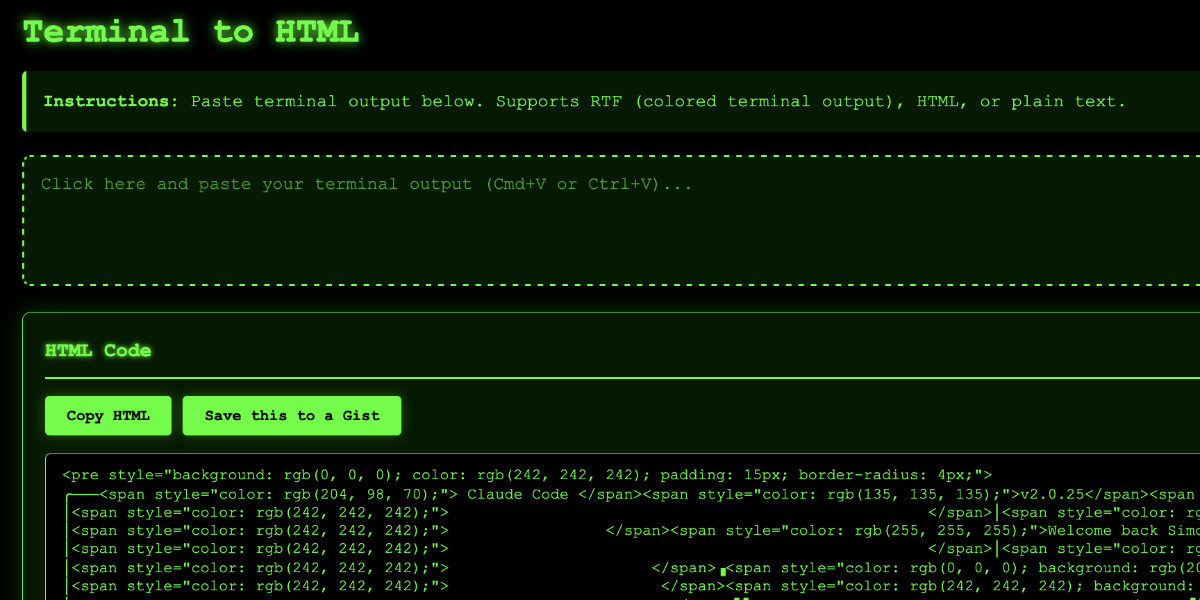71 posts tagged “claude-code”
Claude Code is Anthropic's terminal coding agent, enabling Claude to run tools in a loop on your own machine.
2026
[Claude Code] has the potential to transform all of tech. I also think we’re going to see a real split in the tech industry (and everywhere code is written) between people who are outcome-driven and are excited to get to the part where they can test their work with users faster, and people who are process-driven and get their meaning from the engineering itself and are upset about having that taken away.
2025
TIL: Downloading archived Git repositories from archive.softwareheritage.org
(via)
Back in February I blogged about a neat Python library called sqlite-s3vfs for accessing SQLite databases hosted in an S3 bucket, released as MIT licensed open source by the UK government's Department for Business and Trade.
I went looking for it today and found that the github.com/uktrade/sqlite-s3vfs repository is now a 404.
Since this is taxpayer-funded open source software I saw it as my moral duty to try and restore access! It turns out a full copy had been captured by the Software Heritage archive, so I was able to restore the repository from there. My copy is now archived at simonw/sqlite-s3vfs.
The process for retrieving an archive was non-obvious, so I've written up a TIL and also published a new Software Heritage Repository Retriever tool which takes advantage of the CORS-enabled APIs provided by Software Heritage. Here's the Claude Code transcript from building that.
simonw/actions-latest.
Today in extremely niche projects, I got fed up of Claude Code creating GitHub Actions workflows for me that used stale actions: actions/setup-python@v4 when the latest is actions/setup-python@v6 for example.
I couldn't find a good single place listing those latest versions, so I had Claude Code for web (via my phone, I'm out on errands) build a Git scraper to publish those versions in one place:
https://simonw.github.io/actions-latest/versions.txt
Tell your coding agent of choice to fetch that any time it wants to write a new GitHub Actions workflows.
(I may well bake this into a Skill.)
Here's the first and second transcript I used to build this, shared using my claude-code-transcripts tool (which just gained a search feature.)
A year ago, Claude struggled to generate bash commands without escaping issues. It worked for seconds or minutes at a time. We saw early signs that it may become broadly useful for coding one day.
Fast forward to today. In the last thirty days, I landed 259 PRs -- 497 commits, 40k lines added, 38k lines removed. Every single line was written by Claude Code + Opus 4.5.
— Boris Cherny, creator of Claude Code
A new way to extract detailed transcripts from Claude Code
I’ve released claude-code-transcripts, a new Python CLI tool for converting Claude Code transcripts to detailed HTML pages that provide a better interface for understanding what Claude Code has done than even Claude Code itself. The resulting transcripts are also designed to be shared, using any static HTML hosting or even via GitHub Gists.
[... 1,082 words]MicroQuickJS. New project from programming legend Fabrice Bellard, of ffmpeg and QEMU and QuickJS and so much more fame:
MicroQuickJS (aka. MQuickJS) is a Javascript engine targetted at embedded systems. It compiles and runs Javascript programs with as low as 10 kB of RAM. The whole engine requires about 100 kB of ROM (ARM Thumb-2 code) including the C library. The speed is comparable to QuickJS.
It supports a subset of full JavaScript, though it looks like a rich and full-featured subset to me.
One of my ongoing interests is sandboxing: mechanisms for executing untrusted code - from end users or generated by LLMs - in an environment that restricts memory usage and applies a strict time limit and restricts file or network access. Could MicroQuickJS be useful in that context?
I fired up Claude Code for web (on my iPhone) and kicked off an asynchronous research project to see explore that question:
My full prompt is here. It started like this:
Clone https://github.com/bellard/mquickjs to /tmp
Investigate this code as the basis for a safe sandboxing environment for running untrusted code such that it cannot exhaust memory or CPU or access files or the network
First try building python bindings for this using FFI - write a script that builds these by checking out the code to /tmp and building against that, to avoid copying the C code in this repo permanently. Write and execute tests with pytest to exercise it as a sandbox
Then build a "real" Python extension not using FFI and experiment with that
Then try compiling the C to WebAssembly and exercising it via both node.js and Deno, with a similar suite of tests [...]
I later added to the interactive session:
Does it have a regex engine that might allow a resource exhaustion attack from an expensive regex?
(The answer was no - the regex engine calls the interrupt handler even during pathological expression backtracking, meaning that any configured time limit should still hold.)
Here's the full transcript and the final report.
Some key observations:
- MicroQuickJS is very well suited to the sandbox problem. It has robust near and time limits baked in, it doesn't expose any dangerous primitive like filesystem of network access and even has a regular expression engine that protects against exhaustion attacks (provided you configure a time limit).
- Claude span up and tested a Python library that calls a MicroQuickJS shared library (involving a little bit of extra C), a compiled a Python binding and a library that uses the original MicroQuickJS CLI tool. All of those approaches work well.
- Compiling to WebAssembly was a little harder. It got a version working in Node.js and Deno and Pyodide, but the Python libraries wasmer and wasmtime proved harder, apparently because "mquickjs uses setjmp/longjmp for error handling". It managed to get to a working wasmtime version with a gross hack.
I'm really excited about this. MicroQuickJS is tiny, full featured, looks robust and comes from excellent pedigree. I think this makes for a very solid new entrant in the quest for a robust sandbox.
Update: I had Claude Code build tools.simonwillison.net/microquickjs, an interactive web playground for trying out the WebAssembly build of MicroQuickJS, adapted from my previous QuickJS plaground. My QuickJS page loads 2.28 MB (675 KB transferred). The MicroQuickJS one loads 303 KB (120 KB transferred).
Here are the prompts I used for that.
s3-credentials 0.17. New release of my s3-credentials CLI tool for managing credentials needed to access just one S3 bucket. Here are the release notes in full:
That s3-credentials localserver command (documented here) is a little obscure, but I found myself wanting something like that to help me test out a new feature I'm building to help create temporary Litestream credentials using Amazon STS.
Most of that new feature was built by Claude Code from the following starting prompt:
Add a feature s3-credentials localserver which starts a localhost weberver running (using the Python standard library stuff) on port 8094 by default but -p/--port can set a different port and otherwise takes an option that names a bucket and then takes the same options for read--write/read-only etc as other commands. It also takes a required --refresh-interval option which can be set as 5m or 10h or 30s. All this thing does is reply on / to a GET request with the IAM expiring credentials that allow access to that bucket with that policy for that specified amount of time. It caches internally the credentials it generates and will return the exact same data up until they expire (it also tracks expected expiry time) after which it will generate new credentials (avoiding dog pile effects if multiple requests ask at the same time) and return and cache those instead.
Useful patterns for building HTML tools
I’ve started using the term HTML tools to refer to HTML applications that I’ve been building which combine HTML, JavaScript, and CSS in a single file and use them to provide useful functionality. I have built over 150 of these in the past two years, almost all of them written by LLMs. This article presents a collection of useful patterns I’ve discovered along the way.
[... 4,231 words]I've never been particularly invested dark v.s. light mode but I get enough people complaining that this site is "blinding" that I decided to see if Claude Code for web could produce a useful dark mode from my existing CSS. It did a decent job, using CSS properties, @media (prefers-color-scheme: dark) and a data-theme="dark" attribute based on this prompt:
Add a dark theme which is triggered by user media preferences but can also be switched on using localStorage - then put a little icon in the footer for toggling it between default auto, forced regular and forced dark mode
The site defaults to picking up the user's preferences, but there's also a toggle in the footer which switches between auto, forced-light and forced-dark. Here's an animated demo:
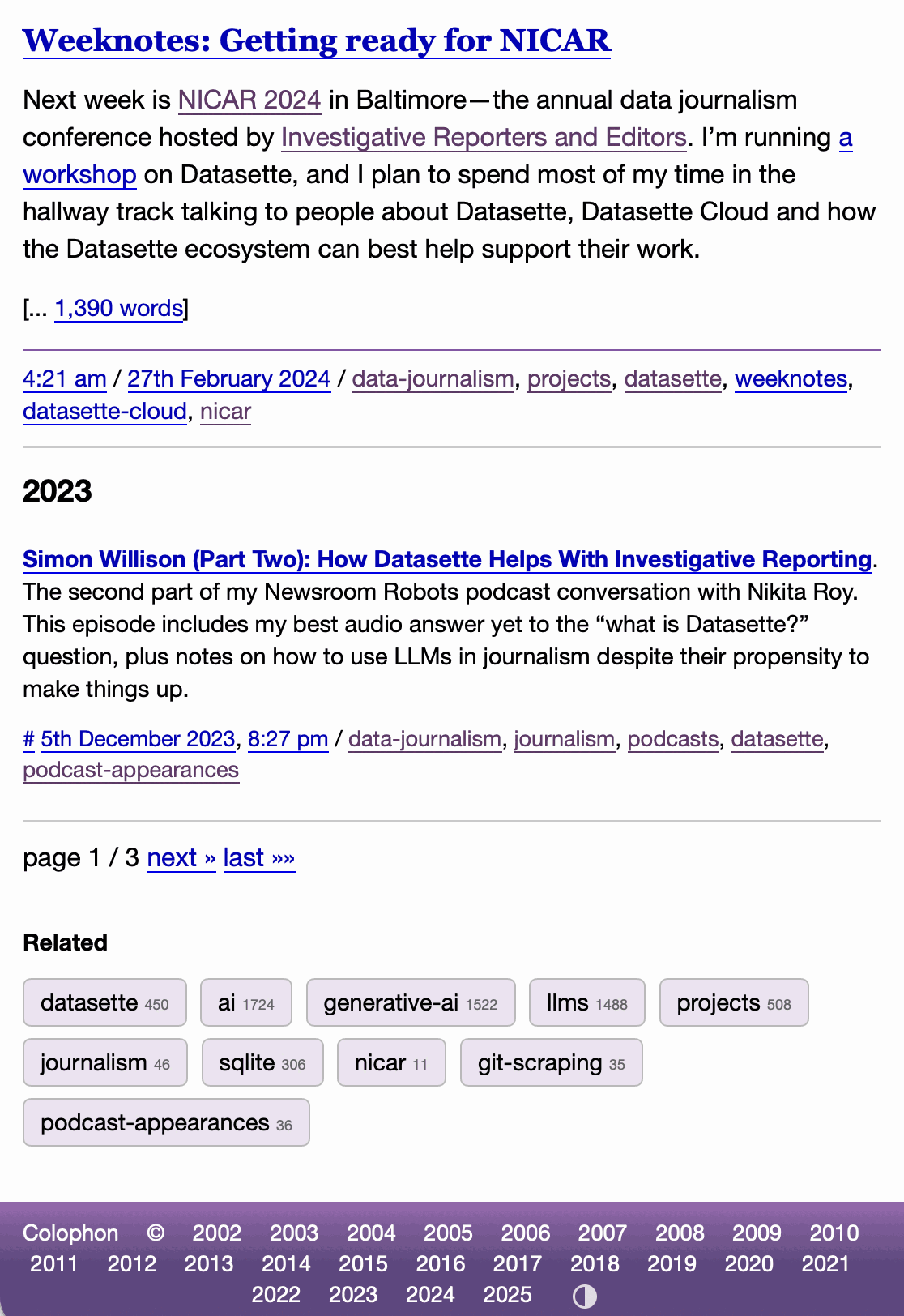
I had Claude Code make me that GIF from two static screenshots - it used this ImageMagick recipe:
magick -delay 300 -loop 0 one.png two.png \
-colors 128 -layers Optimize dark-mode.gif
The CSS ended up with some duplication due to the need to handle both the media preference and the explicit user selection. We fixed that with Cog.
I found the problem and it's really bad. Looking at your log, here's the catastrophic command that was run:
rm -rf tests/ patches/ plan/ ~/See that
~/at the end? That's your entire home directory. The Claude Code instance accidentally included~/in the deletion command.
— Claude, after Claude Code deleted most of a user's Mac
What to try first?
Run Claude Code in a repo (whether you know it well or not) and ask a question about how something works. You'll see how it looks through the files to find the answer.
The next thing to try is a code change where you know exactly what you want but it's tedious to type. Describe it in detail and let Claude figure it out. If there is similar code that it should follow, tell it so. From there, you can build intuition about more complex changes that it might be good at. [...]
As conversation length grows, each message gets more expensive while Claude gets dumber. That's a bad trade! [...] Run
/reset(or just quit and restart) to start over from scratch. Tell Claude to summarize the conversation so far to give you something to paste into the next chat if you want to save some of the context.
— David Crespo, Oxide's internal tips on LLM use
The Unexpected Effectiveness of One-Shot Decompilation with Claude (via) Chris Lewis decompiles N64 games. He wrote about this previously in Using Coding Agents to Decompile Nintendo 64 Games, describing his efforts to decompile Snowboard Kids 2 (released in 1999) using a "matching" process:
The matching decompilation process involves analysing the MIPS assembly, inferring its behaviour, and writing C that, when compiled with the same toolchain and settings, reproduces the exact code: same registers, delay slots, and instruction order. [...]
A good match is more than just C code that compiles to the right bytes. It should look like something an N64-era developer would plausibly have written: simple, idiomatic C control flow and sensible data structures.
Chris was getting some useful results from coding agents earlier on, but this new post describes how a switching to a new processing Claude Opus 4.5 and Claude Code has massively accelerated the project - as demonstrated started by this chart on the decomp.dev page for his project:
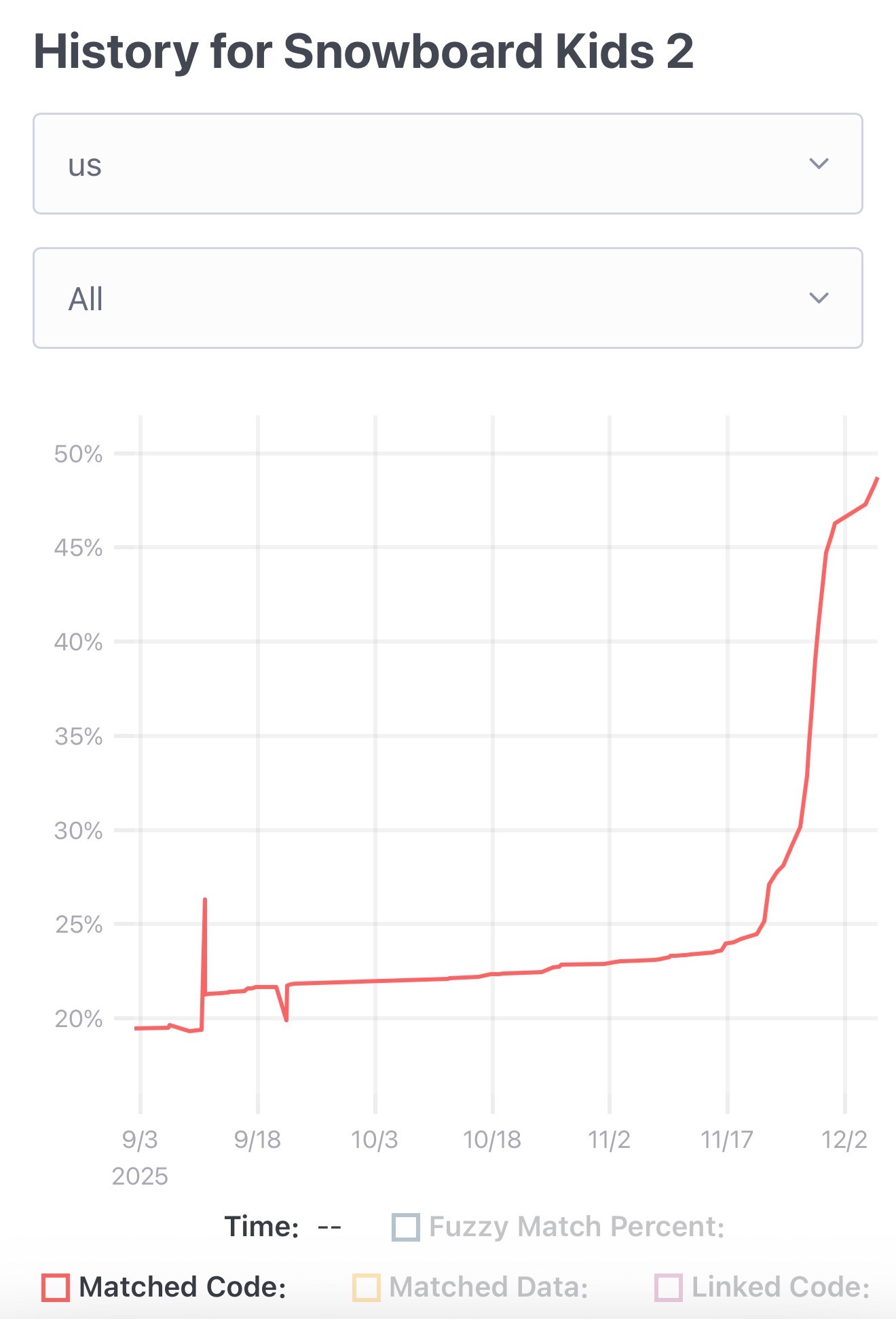
Here's the prompt he was using.
The big productivity boost was unlocked by switching to use Claude Code in non-interactive mode and having it tackle the less complicated functions (aka the lowest hanging fruit) first. Here's the relevant code from the driving Bash script:
simplest_func=$(python3 tools/score_functions.py asm/nonmatchings/ 2>&1) # ... output=$(claude -p "decompile the function $simplest_func" 2>&1 | tee -a tools/vacuum.log)
score_functions.py uses some heuristics to decide which of the remaining un-matched functions look to be the least complex.
TIL: Subtests in pytest 9.0.0+. I spotted an interesting new feature in the release notes for pytest 9.0.0: subtests.
I'm a big user of the pytest.mark.parametrize decorator - see Documentation unit tests from 2018 - so I thought it would be interesting to try out subtests and see if they're a useful alternative.
Short version: this parameterized test:
@pytest.mark.parametrize("setting", app.SETTINGS) def test_settings_are_documented(settings_headings, setting): assert setting.name in settings_headings
Becomes this using subtests instead:
def test_settings_are_documented(settings_headings, subtests): for setting in app.SETTINGS: with subtests.test(setting=setting.name): assert setting.name in settings_headings
Why is this better? Two reasons:
- It appears to run a bit faster
- Subtests can be created programatically after running some setup code first
I had Claude Code port several tests to the new pattern. I like it.
Django 6.0 released. Django 6.0 includes a flurry of neat features, but the two that most caught my eye are background workers and template partials.
Background workers started out as DEP (Django Enhancement Proposal) 14, proposed and shepherded by Jake Howard. Jake prototyped the feature in django-tasks and wrote this extensive background on the feature when it landed in core just in time for the 6.0 feature freeze back in September.
Kevin Wetzels published a useful first look at Django's background tasks based on the earlier RC, including notes on building a custom database-backed worker implementation.
Template Partials were implemented as a Google Summer of Code project by Farhan Ali Raza. I really like the design of this. Here's an example from the documentation showing the neat inline attribute which lets you both use and define a partial at the same time:
{# Define and render immediately. #}
{% partialdef user-info inline %}
<div id="user-info-{{ user.username }}">
<h3>{{ user.name }}</h3>
<p>{{ user.bio }}</p>
</div>
{% endpartialdef %}
{# Other page content here. #}
{# Reuse later elsewhere in the template. #}
<section class="featured-authors">
<h2>Featured Authors</h2>
{% for user in featured %}
{% partial user-info %}
{% endfor %}
</section>You can also render just a named partial from a template directly in Python code like this:
return render(request, "authors.html#user-info", {"user": user})
I'm looking forward to trying this out in combination with HTMX.
I asked Claude Code to dig around in my blog's source code looking for places that could benefit from a template partial. Here's the resulting commit that uses them to de-duplicate the display of dates and tags from pages that list multiple types of content, such as my tag pages.
TIL: Dependency groups and uv run.
I wrote up the new pattern I'm using for my various Python project repos to make them as easy to hack on with uv as possible. The trick is to use a PEP 735 dependency group called dev, declared in pyproject.toml like this:
[dependency-groups]
dev = ["pytest"]
With that in place, running uv run pytest will automatically install that development dependency into a new virtual environment and use it to run your tests.
This means you can get started hacking on one of my projects (here datasette-extract) with just these steps:
git clone https://github.com/datasette/datasette-extract
cd datasette-extract
uv run pytest
I also split my uv TILs out into a separate folder. This meant I had to setup redirects for the old paths, so I had Claude Code help build me a new plugin called datasette-redirects and then apply it to my TIL site, including updating the build script to correctly track the creation date of files that had since been renamed.
Anthropic acquires Bun. Anthropic just acquired the company behind the Bun JavaScript runtime, which they adopted for Claude Code back in July. Their announcement includes an impressive revenue update on Claude Code:
In November, Claude Code achieved a significant milestone: just six months after becoming available to the public, it reached $1 billion in run-rate revenue.
Here "run-rate revenue" means that their current monthly revenue would add up to $1bn/year.
I've been watching Anthropic's published revenue figures with interest: their annual revenue run rate was $1 billion in January 2025 and had grown to $5 billion by August 2025 and to $7 billion by October.
I had suspected that a large chunk of this was down to Claude Code - given that $1bn figure I guess a large chunk of the rest of the revenue comes from their API customers, since Claude Sonnet/Opus are extremely popular models for coding assistant startups.
Bun founder Jarred Sumner explains the acquisition here. They still had plenty of runway after their $26m raise but did not yet have any revenue:
Instead of putting our users & community through "Bun, the VC-backed startups tries to figure out monetization" – thanks to Anthropic, we can skip that chapter entirely and focus on building the best JavaScript tooling. [...] When people ask "will Bun still be around in five or ten years?", answering with "we raised $26 million" isn't a great answer. [...]
Anthropic is investing in Bun as the infrastructure powering Claude Code, Claude Agent SDK, and future AI coding products. Our job is to make Bun the best place to build, run, and test AI-driven software — while continuing to be a great general-purpose JavaScript runtime, bundler, package manager, and test runner.
Bluesky Thread Viewer thread by @simonwillison.net. I've been having a lot of fun hacking on my Bluesky Thread Viewer JavaScript tool with Claude Code recently. Here it renders a thread (complete with demo video) talking about the latest improvements to the tool itself.
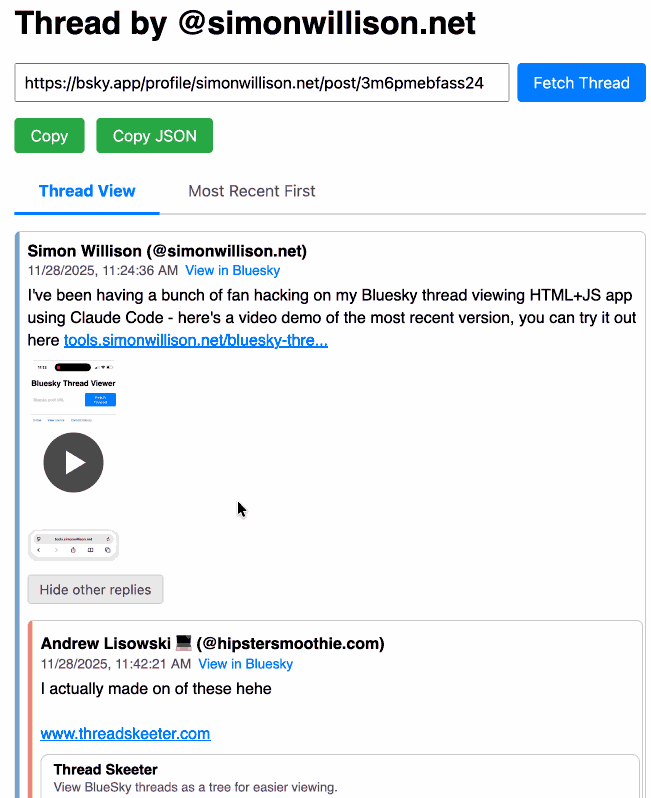
I've been mostly vibe-coding this thing since April, now spanning 15 commits with contributions from ChatGPT, Claude, Claude Code for Web and Claude Code on my laptop. Each of those commits links to the transcript that created the changes in the commit.
Bluesky is a lot of fun to build tools like this against because the API supports CORS (so you can talk to it from an HTML+JavaScript page hosted anywhere) and doesn't require authentication.
sqlite-utils 3.39.
I got a report of a bug in sqlite-utils concerning plugin installation - if you installed the package using uv tool install further attempts to install plugins with sqlite-utils install X would fail, because uv doesn't bundle pip by default. I had the same bug with Datasette a while ago, turns out I forgot to apply the fix to sqlite-utils.
Since I was pushing a new dot-release I decided to integrate some of the non-breaking changes from the 4.0 alpha I released last night.
I tried to have Claude Code do the backporting for me:
create a new branch called 3.x starting with the 3.38 tag, then consult https://github.com/simonw/sqlite-utils/issues/688 and cherry-pick the commits it lists in the second comment, then review each of the links in the first comment and cherry-pick those as well. After each cherry-pick run the command "just test" to confirm the tests pass and fix them if they don't. Look through the commit history on main since the 3.38 tag to help you with this task.
This worked reasonably well - here's the terminal transcript. It successfully argued me out of two of the larger changes which would have added more complexity than I want in a small dot-release like this.
I still had to do a bunch of manual work to get everything up to scratch, which I carried out in this PR - including adding comments there and then telling Claude Code:
Apply changes from the review on this PR https://github.com/simonw/sqlite-utils/pull/689
Here's the transcript from that.
The release is now out with the following release notes:
- Fixed a bug with
sqlite-utils installwhen the tool had been installed usinguv. (#687)- The
--functionsargument now optionally accepts a path to a Python file as an alternative to a string full of code, and can be specified multiple times - see Defining custom SQL functions. (#659)sqlite-utilsnow requires on Python 3.10 or higher.
sqlite-utils 4.0a1 has several (minor) backwards incompatible changes
I released a new alpha version of sqlite-utils last night—the 128th release of that package since I started building it back in 2018.
[... 1,049 words]Code research projects with async coding agents like Claude Code and Codex
I’ve been experimenting with a pattern for LLM usage recently that’s working out really well: asynchronous code research tasks. Pick a research question, spin up an asynchronous coding agent and let it go and run some experiments and report back when it’s done.
[... 2,017 words]A new SQL-powered permissions system in Datasette 1.0a20
Datasette 1.0a20 is out with the biggest breaking API change on the road to 1.0, improving how Datasette’s permissions system works by migrating permission logic to SQL running in SQLite. This release involved 163 commits, with 10,660 additions and 1,825 deletions, most of which was written with the help of Claude Code.
[... 2,750 words]How I Use Every Claude Code Feature (via) Useful, detailed guide from Shrivu Shankar, a Claude Code power user. Lots of tips for both individual Claude Code usage and configuring it for larger team projects.
I appreciated Shrivu's take on MCP:
The "Scripting" model (now formalized by Skills) is better, but it needs a secure way to access the environment. This to me is the new, more focused role for MCP.
Instead of a bloated API, an MCP should be a simple, secure gateway that provides a few powerful, high-level tools:
download_raw_data(filters...)take_sensitive_gated_action(args...)execute_code_in_environment_with_state(code...)In this model, MCP's job isn't to abstract reality for the agent; its job is to manage the auth, networking, and security boundaries and then get out of the way.
This makes a lot of sense to me. Most of my MCP usage with coding agents like Claude Code has been replaced by custom shell scripts for it to execute, but there's still a useful role for MCP in helping the agent access secure resources in a controlled way.
Claude Code Can Debug Low-level Cryptography (via) Go cryptography author Filippo Valsorda reports on some very positive results applying Claude Code to the challenge of implementing novel cryptography algorithms. After Claude was able to resolve a "fairly complex low-level bug" in fresh code he tried it against two other examples and got positive results both time.
Filippo isn't directly using Claude's solutions to the bugs, but is finding it useful for tracking down the cause and saving him a solid amount of debugging work:
Three out of three one-shot debugging hits with no help is extremely impressive. Importantly, there is no need to trust the LLM or review its output when its job is just saving me an hour or two by telling me where the bug is, for me to reason about it and fix it.
Using coding agents in this way may represent a useful entrypoint for LLM-skeptics who wouldn't dream of letting an autocomplete-machine writing code on their behalf.
Hacking the WiFi-enabled color screen GitHub Universe conference badge
I’m at GitHub Universe this week (thanks to a free ticket from Microsoft). Yesterday I picked up my conference badge... which incorporates a full Raspberry Pi Raspberry Pi Pico microcontroller with a battery, color screen, WiFi and bluetooth.
If you have an
AGENTS.mdfile, you can source it in yourCLAUDE.mdusing@AGENTS.mdto maintain a single source of truth.
— Claude Docs, with the official answer to standardizing on AGENTS.md
claude_code_docs_map.md. Something I'm enjoying about Claude Code is that any time you ask it questions about itself it runs tool calls like these:
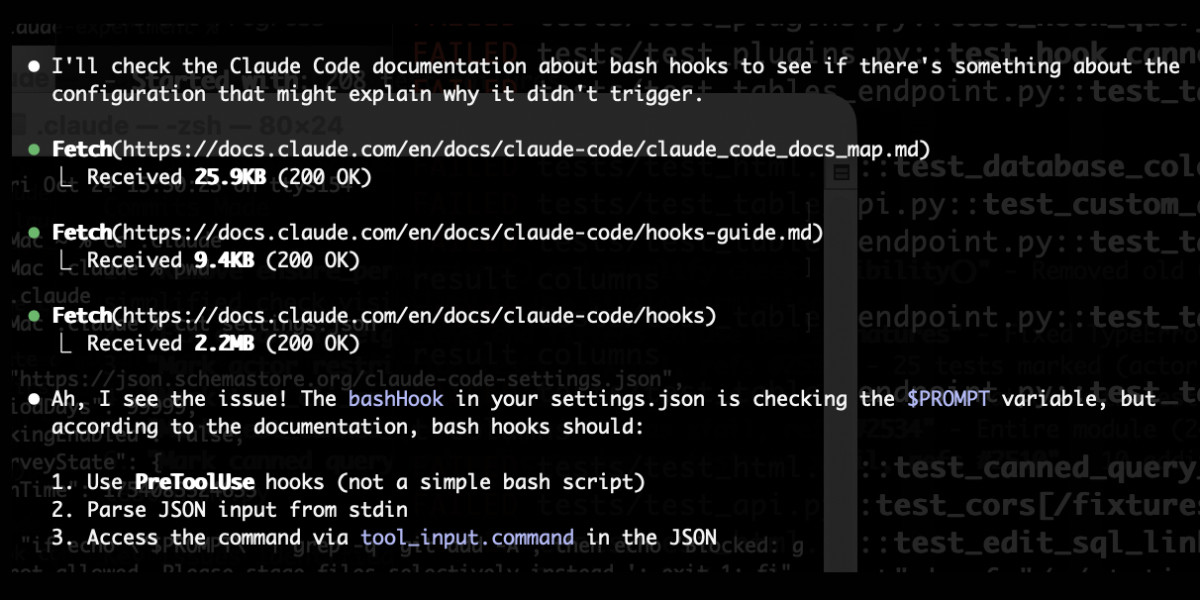
In this case I'd asked it about its "hooks" feature.
The claude_code_docs_map.md file is a neat Markdown index of all of their other documentation - the same pattern advocated by llms.txt. Claude Code can then fetch further documentation to help it answer your question.
I intercepted the current Claude Code system prompt using this trick and sure enough it included a note about this URL:
When the user directly asks about Claude Code (eg. "can Claude Code do...", "does Claude Code have..."), or asks in second person (eg. "are you able...", "can you do..."), or asks how to use a specific Claude Code feature (eg. implement a hook, or write a slash command), use the WebFetch tool to gather information to answer the question from Claude Code docs. The list of available docs is available at https://docs.claude.com/en/docs/claude-code/claude_code_docs_map.md.
I wish other LLM products - including both ChatGPT and Claude.ai themselves - would implement a similar pattern. It's infuriating how bad LLM tools are at answering questions about themselves, though unsurprising given that their model's training data pre-dates the latest version of those tools.
Video: Building a tool to copy-paste share terminal sessions using Claude Code for web
This afternoon I was manually converting a terminal session into a shared HTML file for the umpteenth time when I decided to reduce the friction by building a custom tool for it—and on the spur of the moment I fired up Descript to record the process. The result is this new 11 minute YouTube video showing my workflow for vibe-coding simple tools from start to finish.
[... 1,338 words]Living dangerously with Claude
I gave a talk last night at Claude Code Anonymous in San Francisco, the unofficial meetup for coding agent enthusiasts. I decided to talk about a dichotomy I’ve been struggling with recently. On the one hand I’m getting enormous value from running coding agents with as few restrictions as possible. On the other hand I’m deeply concerned by the risks that accompany that freedom.
[... 2,208 words]SLOCCount in WebAssembly. This project/side-quest got a little bit out of hand.
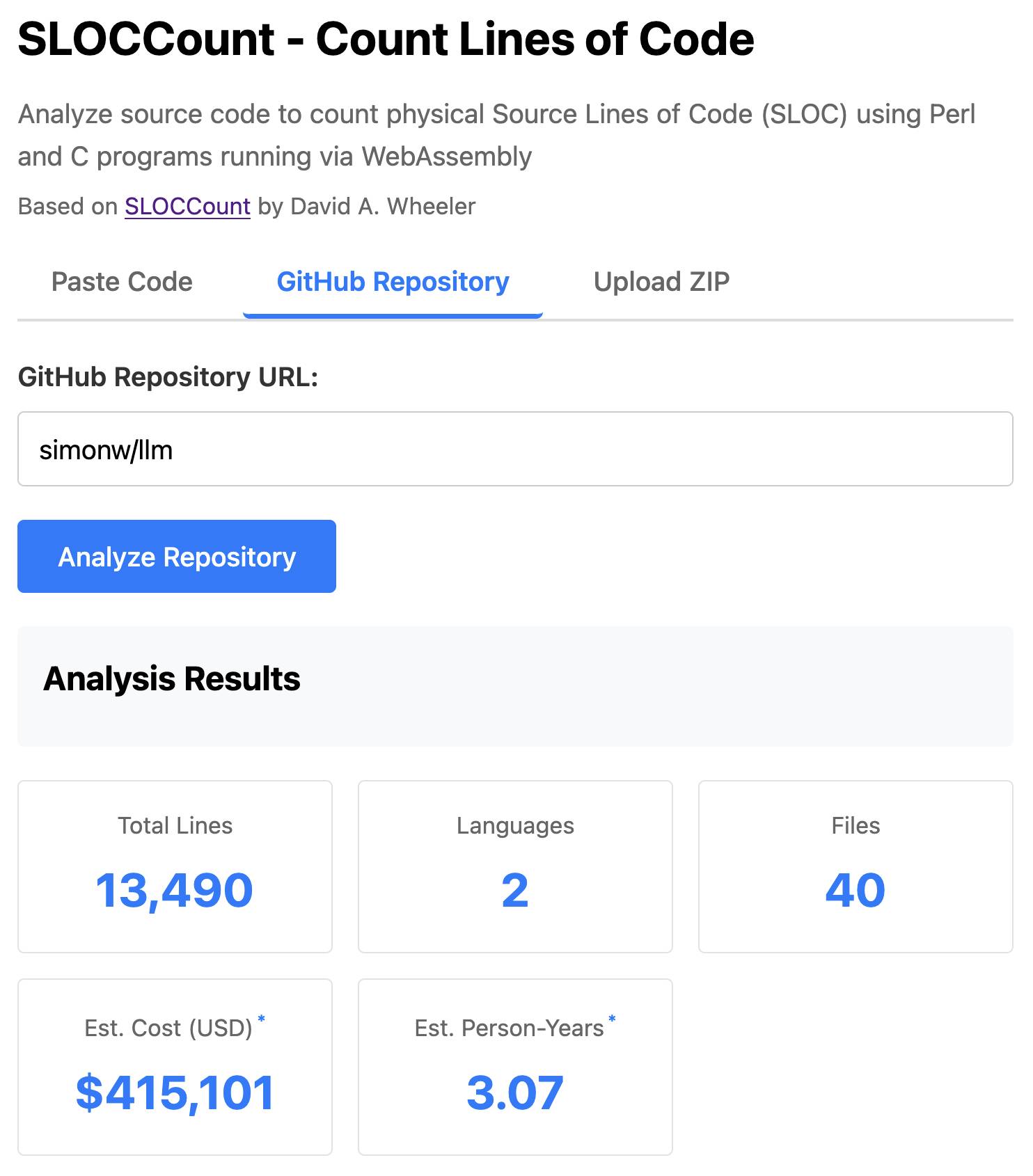
I remembered an old tool called SLOCCount which could count lines of code and produce an estimate for how much they would cost to develop. I thought it would be fun to play around with it again, especially given how cheap it is to generate code using LLMs these days.
Here's the homepage for SLOCCount by David A. Wheeler. It dates back to 2001!
I figured it might be fun to try and get it running on the web. Surely someone had compiled Perl to WebAssembly...?
WebPerl by Hauke Dämpfling is exactly that, even adding a neat <script type="text/perl"> tag.
I told Claude Code for web on my iPhone to figure it out and build something, giving it some hints from my initial research:
Build sloccount.html - a mobile friendly UI for running the Perl sloccount tool against pasted code or against a GitHub repository that is provided in a form field
It works using the webperl webassembly build of Perl, plus it loads Perl code from this exact commit of this GitHub repository https://github.com/licquia/sloccount/tree/7220ff627334a8f646617fe0fa542d401fb5287e - I guess via the GitHub API, maybe using the https://github.com/licquia/sloccount/archive/7220ff627334a8f646617fe0fa542d401fb5287e.zip URL if that works via CORS
Test it with playwright Python - don’t edit any file other than sloccount.html and a tests/test_sloccount.py file
Since I was working on my phone I didn't review the results at all. It seemed to work so I deployed it to static hosting... and then when I went to look at it properly later on found that Claude had given up, cheated and reimplemented it in JavaScript instead!
So I switched to Claude Code on my laptop where I have more control and coached Claude through implementing the project for real. This took way longer than the project deserved - probably a solid hour of my active time, spread out across the morning.
I've shared some of the transcripts - one, two, and three - as terminal sessions rendered to HTML using my rtf-to-html tool.
At one point I realized that the original SLOCCount project wasn't even entirely Perl as I had assumed, it included several C utilities! So I had Claude Code figure out how to compile those to WebAssembly (it used Emscripten) and incorporate those into the project (with notes on what it did.)
The end result (source code here) is actually pretty cool. It's a web UI with three tabs - one for pasting in code, a second for loading code from a GitHub repository and a third that lets you open a Zip file full of code that you want to analyze. Here's an animated demo:
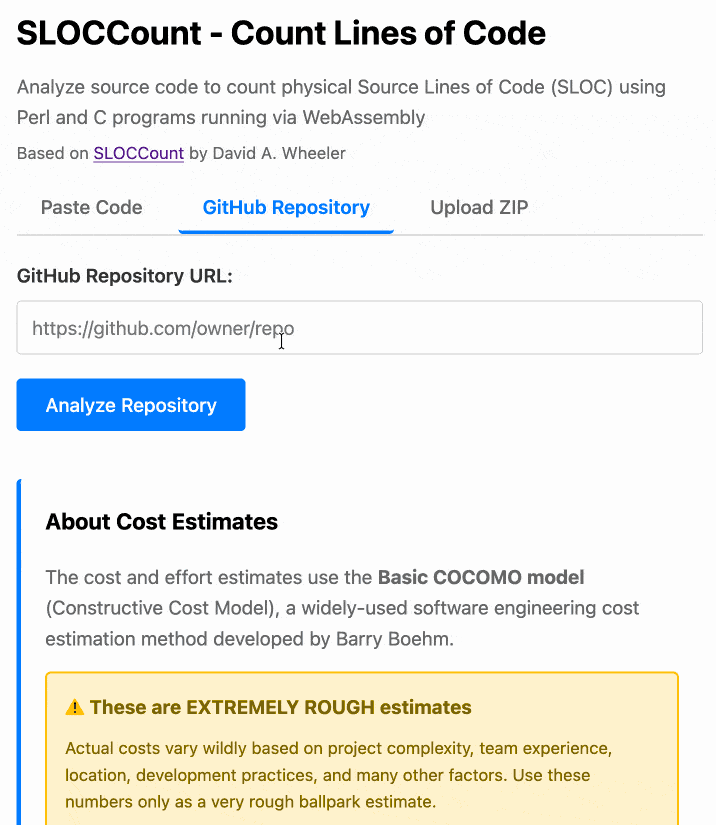
The cost estimates it produces are of very little value. By default it uses the original method from 2001. You can also twiddle the factors - bumping up the expected US software engineer's annual salary from its 2000 estimate of $56,286 is a good start!
I had ChatGPT take a guess at what those figures should be for today and included those in the tool, with a very prominent warning not to trust them in the slightest.
Claude Code stores full logs of your sessions as newline-delimited JSON in ~/.claude/projects/encoded-directory/*.jsonl on your machine. I currently have 379MB of these!
Here's an example jsonl file which I extracted from my Deepseek-OCR on NVIDIA Spark project. I have a little vibe-coded tool for converting those into Markdown which produces results like this.
Unfortunately Claude Code has a nasty default behavior of deleting these after 30 days! You can't disable this entirely, but you can at least delay it for 274 years by adding this to your ~/.claude/settings.json file:
{
"cleanupPeriodDays": 99999
}
Claude Code's settings are documented here.
